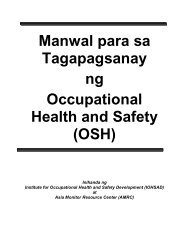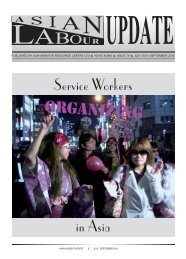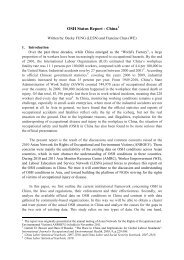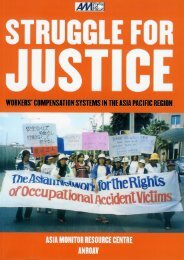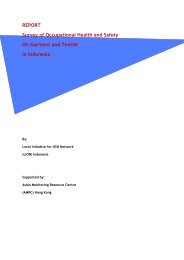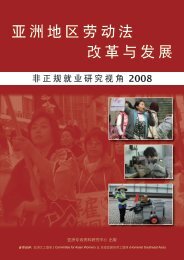BURMESE GARMENT WORKERS - Asia Monitor Resource Center
BURMESE GARMENT WORKERS - Asia Monitor Resource Center
BURMESE GARMENT WORKERS - Asia Monitor Resource Center
Create successful ePaper yourself
Turn your PDF publications into a flip-book with our unique Google optimized e-Paper software.
O S H T r a i n i n gOCCUPATIONAL SAFETY ANDHEALTH TRAININGFOR<strong>BURMESE</strong><strong>GARMENT</strong> <strong>WORKERS</strong>March 26 to 27, 2005Organised byYang Chi Oo Centre<strong>Asia</strong> <strong>Monitor</strong> <strong>Resource</strong> CentreThai Labour Campaign
AcknowledgementsThis training report is prepared more like a manual, so that it can be used as a guide. We would like to express our thanks toMelody Kemp, Dennis Arnold, and Deepa Bharthi for their contributions. We would also like to thank the Burmese workerswho in spite of many difficulties participated in this training.Much of the information material used in this report has come from three main manuals:1.Health and Safety Training, binder developed by the Labor Occupational Health Program (LOHP) at the University of California,Berkeley and the Maquiladora Health and Safety Support Network (MHSSN). For further information, please contact GarrettBrown at gdbrown@igc.org.2. The illustrations from the Hesperian Foundation are from a forthcoming book on health and organizing for workersin export factories. For more information on the book, contact Maggie Robbins by email at maggie@hesperian.org or bytelephone at+1-510-845-1447, x222. For information on other publication of the Hesperian Foundation go to www.hesperian.org .3. Working for Life: Sourcebook on Occupational Health for Women, by Melody Kemp, Published by ISIS international. Thisbook is available online on AMRC website at http://www.amrc.org.hk/Working%20for%20Life.htm
Background and Introduction There are between 1.5 and 2 million migrant workers inThailand, roughly 80 percent are Burmese. Mae Sot is aborder town in Tak Province in the north of Thailand across theMoei River from Mywaddy, Burma, and is host to some 100,000Burmese workers employed primarily in textile and garmentfactories, other manufacturing industries, and agriculturalwork. For nearly ten years factories operating in Thailandhave been opening in and relocating to Mae Sot, followingthe Thai government policy of ‘constructive engagement’ withBurma which began in the early 1990s. With this policy camean increasingly porous border, in terms of capital, goods andlabour. As the cost of labour increased during Thailand’sboom decade of 1986-96 a steadily increasing number ofmigrant workers have come to Thailand to take low-wage jobsoften shunned by locals, primarily in fisheries and seafoodprocessing, plantations and agriculture, domestic work andmanufacturing.Over the years Mae Sot has become synonymous withlabour rights abuse and extreme forms of exploitation,as is documented in reports from the City University of HongKong Southeast <strong>Asia</strong> Research Centre, Amnesty International,Physicians for Human Rights, and the ICFTU among a numberof others. Despite migrants’ legal inability to form registeredtrade unions, many still seek to informally organise unilaterallywithin workplaces, and/or with the assistance of unions andlabour support organisations; in nearly every case theseorganisations are Burmese. But organising migrant workers isdifficult. Migrant workers often have only one day off a month,and are not always permitted to leave the factory compoundon Saturday or Sunday night, making it difficult to contactworkers. In addition, employers regularly take advantage of thevulnerability of these workers, and dismissal is often arbitrary,meaning that workers are unwilling to take any actions that maybe perceived as risky. Following dismissal and in many casespreceding it, immigration officials are routinely called in byemployers to deport both regular and irregular migrant workers.Time and again, when Burmese migrant workers have attemptedto alter their conditions of work, have demanded their rightsthrough informal collective bargaining agreements, organisedwalk-outs and wildcat strikes or have simply attempted toengage in dialogue over working conditions, they have beensacked and usually find themselves deported. Arnold, D (2004) The situation of BurmeseMigrant Workers in Mae Sot, Thailand, City Universityof Hong Kong, Southeast <strong>Asia</strong> Research Centre,Working Papers Series, #71 [http://www.cityu.edu.hk/searc/WP.html].Training AimsThe long-term objective of this training and subsequentfollows up, are to develop local Burmese migrantorganisations as resources for workers on OSH issues (withcapacity of research, training and advocacy), develop a OSHpolicy within the organisation. Additionally, develop theorganisations to take a leadership role in protecting theworkers OSH rights based on the international best practices asprescribed under the ILO conventions.The immediate objectives of this training were:• To introduce occupational health and safetyissues to garment factory workers in Mae Sotand build upon workers existing knowledge• To provide the tools and knowledge localorganizations and workers need to address OSHissues with support from national and regionallevel organizations• To develop basic health and safety understandingof the representatives of various grassrootsorganisations, factory workers and futuretrainers.• To develop understanding about the generalhazards (physical, chemical, ergonomicbiological and physiological) prevalent at thework place, their evaluation and the means fortheir prevention.• To encourage participants to translate theirlearning into practical measures (for example,the formation of safety committees, or otheraction as deemed appropriate by the workersorganisation)• To encourage the participants to identify ordevelop a resource centre(local) which workerscan rely upon for information• Focus on the specific occupational hazardswhich women face at work.ParticipantsThe participants comprised of knitting and garment factoryworkers, Mae Sot health clinic staff, Local, national andregional NGOs
TrainersMeldy Kemp, a renowed OSH expert and Regional Council Member of AMRC and Sajiv Pandita from AMRC were the trainerssupported by Dennis Arnold fro TLC and Deepa Bharthi from CAW.Methodology: The workshop was conducted in a participatory format using interactive techniques like group work, role playand other interactive session. Since occupational health and safety training also involves some technical details which isimportant, utmost care was taken to make to provide information available to workers in interactive format as often as possible.
ProceedingsDay 1The training programme started with the welcome,introductions from YCOWA, TLC, Melody and AMRC,explanation of the purpose and objectives of the workshop.This was followed by the introduction of the participants. Thefacilitators of the workshop explained the two day schedule andprocesses and asked for feedback from the participants.Session 1: Identification and Prioritising ofthe common workplace hazardsThis exercise was designed to allow workers to both identifyand prioritise hazards. The exercise comprised of seriesof cards depicting well known hazards such as electric shock,mechanical safety, fatigue and stress. Workers are asked to rankthem according to various criteria, in this case to rate issuesof common interest to both types of factories. The results arelisted in Table 1. belowTable 1Issues common to BothGroups in Order ofPriorityIssues of Importanceto Garment workers inOrder of those causingmost Injuries/illness ordeathIssues of Importanceto Knitting Workers inOrder of those causingInjury/illness or deathSexual harassment Electric shock Poor ventilationPoor ventilation Poor ventilation Electric shockToo much work Too much work Too Much WorkAggression/intimidation Sexual harassment Aggression/intimidationElectric shocks Chemicals Sexual harassmentReproductive concerns Reproductive concerns Reproductive concernsChemicalsPoor seating/NoiseNoiseergonomicsAggression/intimidation Not enough to eat orNot enough o eat or drink Not enough to eat ordrinkPoor seating/ergonomicsdrinkPoor seating/ergonomics Actual birth deformities ChemicalsLack of access to toilets Noise Actual birth deformitiesActual birth deformitiesRestricted access totoiletsToilet access.
Session 2: Factory Hazard MappingThe aim of this exercise was to identify hazards in thedifferent sections of the factory. In this exercise, theparticipants draw the map of their factory as if they are lookingat it from above (aerial view. They draw all possible sectionsand possible hazards in each section.The participants were divided into four groups, three groupsfrom the knitwear factories and one group of garmentfactory. A majority of workers who participated in the workshopcame from the knitwear factories. The basic difference betweenthe garment and a knitwear factory is that in a knitwear factory,the yarn is knitted into a definite pattern before sewing it into agarment whereas in the other garment factory, the cloth is cutand then sewed into garments. The group were given some timefor discussion and preparation and then each group presentedthe findings to the participants.Group 1 to 3 (Knitwear)Most of knitwear factories have the following sections:Warehouse/Store•Knitting Section•• Sewing•• PackagingBoiler and Washing Section•Residential Area•Management Office••Toilets•Finishing and Quality ControlWaste Disposal/Dumping AreaThe workplace hazards identified by workers in each section:In warehouse/store the light is not enough, the•materials are placed haphazardly causing frequent falls.Workers have to lift heavy weights. Raw materials aresometimes stored upstairs and have to be manually handleddown poorly lit stairwells.In the Knitting section the common hazards are dust• from the yarn that causes many respiratory problems to theworkers. One group also reported that many of the workersin the factory have TB which is an additional risk in thecrowded factory and dormitory conditions which is conduciveto transmission. Workers hands get injured frequently in theknitting machine. Sometimes the hair of women also gets caughtup in the machine. Those working in knitting complainedthat each time they changed the gauge of the fabric made,they would have to change the base plate which is very heavy.These workers are disallowed from wearing shoes and reportedfrequent foot injuries.In most of the sections (except for the sewing section)• workers have to stand for long hours and work in veryuncomfortable postures putting a lot of strain on their lowerbacks and legsIn sewing section workers are provided only hard•stools, without back rests to sit on and they have to sit forvery long hours. Needle prick injuries are very common in thissection.There was some concern expressed about an aging•boiler that was rarely inspected and is located close to themain floor, so any explosion could claim worker fatalities.The workers reported generally hot humid conditions•in their workplaces and dormitories in addition to high levelsof physical and psychological stress.The workplaces are generally very crowded with•very poor ventilation. One group pointed out that therewere only 5 fans in the whole factory and in summer when thetemperatures soar to the high 30’s, they are quite insufficient.In washing section workers use a range of chemicals• and detergents for washing the fabric. The managementdoes not provide any personal protective devices like gloves forwashing. Many of the workers working in this section face skinirritation and other problems due unsafe use of the chemicals.The washing machines are also operated without proper guardsor lock out systems, and sometimes workers hands get caughtup in the machine, causing injuries.Electrical Hazards were reported as one of the major• problem by almost all groups. None of the factories areearthed and water on the floor conducts electricity across theworking floor. The electrical wiring in most of the factories ismessy and can cause trip and fall injuries.. In one factory thesituation is worse as the workers are not allowed to wear shoesin the workplace. This was described as discrimination as therule applies only to Burmese workers, and puts their lives atrisk. Two workers who asked for shoes were simply fired bymanagement.
The store room or material storage area was also•identified as dangerous. All types of materials like chemicals,petrol and waste material is stored in an unbunded storehouse.There is no proper segregation of flammable materials, neitherare they stored in a safe manner. This poses a great health andsafety risk to whole factory.Most of the workplaces in all factories are crowded and• with no or improperly marked fire exits. Many times the fireexits are blocked with materials. There are almost no fire drillsor exercises towards fire safety.The factories in Mae Sot are unique in the sense that•most of the Burmese workers live within the factory premises.Thus there is no clear distinction between their work and livingarea. The residential quarters or dormitories are very crowdedand unhygienic. Workers have to sleep on small shelves on topof each other under utmost inhumane conditions. The roofof many dormitories cannot withstand the rain and in rainyseason the water drips down inside the rooms. In some factoriesdue to lack of space, male and female workers are put in thesame room that causes lots of social problems (I didn’t thinkthis was the case.. but maybe I heard wrongly.. I thought theysaid that the proximity of men women and families added tosocial tensions). It was also reported that the dormitories haveno proper fire exits and in case of a fire there will be lots ofcasualties and due to overcrowding it will be very difficult forthem to escape.One dormitory was situated on the roof of the factory• building. It had been roofed with corrugated iron and insummer was intolerably hot. Only recently had walls beeninstalled to keep the rain out, but it was also cold in winter andwould have been difficult if not impossible to escape from if afire broke outAll the groups reported the widespread abuse of the• Burmese workers at the hands of management (who aremostly Thai). The groups reported that management feel thatthey can treat the workers in any way they like. They fully exploitthe vulnerable position of these workers. In many factoriesthere are separate toilets for the Burmese workers and the Thaimanagement. In some factories even the drinking water for theworkers and the management is kept separately.Apart from regular harassment, violence at workplace• is a big issue. It was reported that workers disappearancesare a regular thing. In one factory a security guard forcibly tookone woman worker outside the factory to some unknown place.She was found dead after some days. All working groups inthe workshop said that such incidents are common. On severaloccasions workers who try to negotiate for better workingconditions or attempt any organising of workers, he or sheis usually sacked and deported, and in several instances hasdisappeared mysteriously and is found dead somewhere.Questions and Answer SessionAfter each group presentation, there was a questionand answer session where the participants would raisequestions and discuss some key issues. Some of the key issuesraised during this session:Inspections: When asked if there are any inspections•(by the labour enforcement authorities), workers respondedby saying that such inspections are very rare. In one factorythere was a labour inspection, but the management hadbeforehand information about the inspection and he askedworkers not to come to work for two days. Others wereinstructed to lie to inspectors about leave and pay.Clinic: The participants reported that generally•there are no proper clinics but just a first aid box in somecorner of the room without any trained staff. They generallyget medications and plasters for small cuts etc. but in case ofserious injury or disease they have to go outside the factory toclinics like Mae Tao clinic. For common illnesses like stomachaches or other body pains, workers do not visit doctors but usemedications on their own.Overtime and Holidays: In most of the factories•workers have to work from 12 to 16 hours. Their day starts at8 am in the morning and they work till 10 or 12 pm in the nightwith just 2 hour breaks at 1 pm and 5 pm. Sometimes during thepeak season they have to work till 5 or 6 am in the morning andthem take a rest for 2 hours and work again from 8 am. Theygenerally get a day off only on 2 Sundays in a month.Group 4 Garmenttypical garment factory in Mae Sot has following sections:AWarehouse/Storage•Cutting Section•Sewing Section•Washing•• Ironing/PressingQuality Control•
Packaging•••Residential AreaManagement OfficeThe workplace hazards identified by the group in thedifferent sections are as under:Most of the sections of the factory are in just one room•(as it is a small factory). It is cramped as there are about 60workers working.The ventilation is improper and insufficient. The•whole workplace is full of dust. There are just 5 fans in thewhole work area and it just circulates the dust laden air withinthe factory. Dust is also an explosive hazard under the rightcircumstances, and considering the substandard wiring, sourcesof ignition are ever present.Electrical wiring is not confined to conduit, circuits are• overloeaded and the premises are not earthed.so pose risk ofelectrical shock and fire.Most of the workers have to work for very long hours• in very uncomfortable positions. In Knitting heavy manualhandling is common.In sewing section, workers have to sit for long hours•In ironing section the common hazards are long•without any breaks and needle prick injures are very common.working hours in uncomfortable position and burns from thesteam and the iron. The space in the ironing section is confinedand workers have to work in cramped and hot place. On top ofit, the factory also stores some materials in this section. Thereare about 8 to 12 workers working in just 15 sq feet room.Workers have to work for long hours sometimes even• 20 hours.There are just 2 toilets for 60 workers in one factory•and they are filthy. Workers are not allowed to use the toiletsat the residential area (which are on the top floor) during workhours.The workers live in the accommodations provided•at the top floor of the factory. There are not ample roomsavailable so sometimes two families are put in one room whichbecomes a very embarrassing social issue.Management abuse of workers is quite rampant.•Questions and AnswersFreedom to go out of the Factory: Some factories allowworkers to go out after the work hours and some do not.This factory is a small one, but big ones have compounds whereworkers have one day to go out, when there is no OT. Otherdays cannot go out of the compound. In some factories workersare not at all allowed to go out of the factory compound, evenif they are sick or injured. They can go out only one day in amonth after the pay day, generally from 6-9pm. On any otherday if workers need to go out, they have to leave some depositlike a gold necklace or ring.Post- Lunch SessionSession 3: ErgonomicsIn this session the facilitator (Melody) explained the workdesign, working posture, repetitive work and its effects on ourbodies.Most of the work performed in knitting and sewing isrepetitive, and involves cramped and poor positioning.Such working conditions are tiring and can cause long terminjuries to the body which can take many months to heal.Noise, poor lighting, and stress contribute to a poor ergonomicenvironment.Patterns develop and are caused by: WORKING in fixedpositions. Muscles get tired and don’t have time to refresh.Doing the same actions repetitively cause pains in the body.Using force with some kinds of work like hammering; twistingis related to tendon and fibrous tissue damage. These injuriesare also made worse by some of the things you do at home,particularly for women with a lot of housework to do. If thesoreness is around for a long time it leads to muscle weakness,to the point that even lifting a cup can be painful. It’s importantto prevent these things. Your body has a memory, if you stopsomething and recover and start doing it again 6 months laterthe body can begin to hurt again.Most workplaces are deisgned for only one body type. Talland short workers have to strain to reach their task surfaceas they are not adjustable. The facilitator demonstrated this byasking one of the participants to sit on a chair. His feet did not
touch the floor and his arms were too high. Melody sat in thesame chair and her feet could touch the ground (she’s muchtaller). A good chair will support the lower back and reducefatigue. Optimal position is with joints at 90 degrees such asthe arms when typing on a computer etc, poorly lit work maycause workers to sit or stand in unnatural positions so theycan see the task at hand.Changing positions and shifting weight reduces fatigue andback pain when performing standing tasks. A foot rest isan inexpensive solution.. The other is to work so your limbsare in a comfortable position (such as when typing or sewing).Source: Hesperian foundationSource: Hesperian foundation
10Source: Hesperian foundationSource: Hesperian foundation
11Exercise on problem solving with drawings ingroups of 2 or 3.The participants were given some illustrations of workersworking in bad postures or carrying heavy loads or workingon repetitive jobs. They were then asked to provide solutionsto resolve these problems and then they were asked to presentto solutions. A solution in some situations is to tip the worksurface up rather than raise it to enable workers to see insideand to make the contents mor accessible. It reduces strainon shoulders and upper arms.. The solutions shown in thisexercise are very cheap and can be done in the factory for littlemoney thus refuting managements arguments that workplaceredesign is expensive. Improvements can be manufactured fromjunk or spare materials like wood, steel or foam.Q: I kind of doubt if factory management will be responsiveto changing their equipment to make it more comfortableto workers.A: addressing changes in factories is a topic for a followup seminar or workshop in cooperation with groups. Theworkshop today is not going to solve all the problems, but apart of a longer process.Body Mapping ExerciseIn this exercise on the figures of human bodies, participantswere asked to mark the part of the body where they felt painon the chart. This exercise helps to understand the commonbody pains workers have and thus can be attributed to theirwork. Virtually all workers indicated they have chronic pain ordiscomfort, despite their youth.Additional InformationGarment workers often suffer from injuries to the back,shoulders, knees arms and hands. These injuries areusually caused by work that pushes body beyond its limits.For example garment workers who sew make small repetitivemovements thousands of times a day. They sit hunched overtheir work for many hours each day. These movements may looksmall and easy from a distance, but the strain on the workers’body is painful and tiring. Work in the garment factory may beharmful even if it does not cause any pain right away. Whenthe injury becomes more serious, the person may feel pain,numbness, weakness or tingling. With some injuries the paingets much worse over time. Sometimes the injury and pain getso bad that the person cannot work.Ergonomics is the study of matching work design to humancapabilities and involves psychological and perceptualdimensions with physical design. A good example is a cockpitin a plane. The pilot has to be able to reach all the controls, beable to clearly see and operate them and they have to respondto her adjustments in an emergency. Ergonomics includesthe study of noise on human performance, lighting, ambienttemperatures, vibration, and colouring, symbols and controls.Poor work postures may impede intake of oxygen which inturn hastens fatigue and onset of pain. Chairs that are notadjustable and lack back rests reduce breathing capacity andinduce fatigue.
12Ergonomics is also the study of how to prevent injuries bydesigning work and equipment that does not push theworkers beyond their limits. Ergonomics proves what mostworkers know already: different parts of the body have limitsand that must be respected or they will become tired. Sinceevery person is different, these limits may vary-but everyone hasthem.Ergonomic Risk FactorsWorkplace elements that cause wear and tear onyour body and can cause injury. To prevent injuries,you should first identify any risk factors. Oncethese have been identified work on finding ways toeliminate them.Risk Factors Definition Possible SolutionsHigh RepetitionExcessive ForceAwkward PostureStatic LoadingDirect PressureVibrationExtreme Cold and/orHeatPoor Work Organizationwhich increases risk ofaccidentPerforming the same motionover and over.Excessive physical effortneeded to do the work– pulling, pounding, pushing.The more effort, the harderyour body works.Bending or twisting any partof your body.Staying in one position toolong, causing muscles tocontract.Contact of the body with ahard surface or edge.Using vibrating tools orequipment.Cold reduces feeling, bloodflow, strength, and balance.Heat increases fatigue.Includes: machine-pacedwork, inadequate breaks,monotonous tasks, andmultiple deadlines.Redesign task to reducethe number of repetitions,motions, or increase recoverytime between repetitions, orrotate to different jobs.Reduce the exertion neededto accomplish the task,redesign task; assign morestaff, use mechanical assistssuch as levers.Design tasks, equipment andtools to keep the body innatural or “neutral” positions.Design tasks to avoidstatic positions, provideopportunities to changepositions.Improve tool and equipmentdesign to eliminate thepressure, or providecushioning material.Isolate the hand fromvibration.Insulate the body; controltemperature.Reasonable workload,sufficient breaks, task variety,individual autonomy.
143. MOUTH:Breathing or swallowing chemicals that have spilledor settled onto food, beverages, cigarettes, beards,or hands4. Eyes: Splashes to the eyes can result in chemicalsentering the body, particularly those that dissolve easily inwater.Once chemicals enter the body, they move into yourbloodstream and reach internal “target” organs, such as theliver, kidneys, or nervous system or are stored in fat.Chronic effects may take years to show up. For instanceoccupational cancer or respiratory failure. They are usuallycaused by regular exposure to a harmful substance over a longperiod of time. These effects are usually permanent.Some chemicals cause both acute and chronic effects. Forexample, breathing solvent vapours might make you dizzyright away (an acute effect). But breathing the same vapours allthe time for many years might eventually cause liver damage (achronic effect).Target Organ: Some Chemicals may not affect you right away.However, they may affect some specific organ, known as‘target organ’, like liver, kidneys or nervous system after someperiod of time.Acute and Chronic EffectsThe effects of a toxic chemical on your body may be eitheracute or chronic.Acute effects show up immediately or soon after yourexposure to the chemical. They may be minor, like nose orthroat irritation. Or they could be serious like eye damage orpassing out from chemical fumes. What all these effects have incommon is that they happen right away.Source: Heath and Safety Training Binder by LOHP andMHSSN.
15How can Chemicals Affect my BodySource: Heath and Safety Training Binder byLOHP and MHSSN.
16Toxic T- Shirt ActivityThe objective of this exercise was to make participantsunderstand the routes of entry of chemicals in our bodies,its acute and chronic (short term and long term effect on ourbodies. The participants were divided into four groups and allof them were given a T-Shirt that has organs of bodies drawnon it. The participants were given sample chemicals with itshealth effects and they were supposed to point the affectedorgans with different colored dots. Then they were asked topresent the findings to larger group.presentations of findings:4Group 1 FormaldehydeIt’s vaporizing affect on the eyes.When it’s inhaled it first affects the throat andthen the lungs, the heart and reproductive organs.Can also affect the skin.Group 2 MEK (Methyl Ethyl Ketone)Headache and eye problems, affects the throat,also heart, lungs, liver, digestion problems in thestomach, kidney, intestine affected and also the reproductivesystem. Others include affects on eyes, bones and nerves.Group 3 TCE (tri Chloro Ethane)By breathing first affect the nose and on to the lungsand the heart. Cause dizziness and eye problemslike not being able to see very clear. Later the heartbeatwill quicken, which affects the nervous system. Other affectsare on the stomach, feel nausea; infect the intestine and thereproductive system.Group 4 carbon disulfideChemical used to clean the fabrics which affect thenose, throat, lungs. Can severely affect the kidneysand nervous system. The heart is also weak because of thischemical. Reproductive system affects women’s menstrualcycle. .D iscussionIt is very important to know the name of the chemicals we workwith. Often management will not disclose the exact nameof the chemicals. Or they will just say the chemical in the redbottle, blue bottle and use it. It’s important to know the nameof the chemical so we know how it affects our health.Q: So how will you get the name of the chemical?A: using chemicals to clean the fabric which affectstheir hands. But hard to know the name exactly.the bottle has a name on it, can try to write the nameSanjiv: while management isn’t looking, because you may get fired,or tear the label and take it to a local organization who can findout what the chemical is. Dennis however, added that due tothe sensitive situation in Mae Sot, workers should not resort tothis technique as it can be very dangerous. There should be aproper discussion with the Yang Chi Oo center so that effectiveand safe means of getting name of chemicals are found.Most chemicals have to have a Material Safety Data Sheetto be sold internationally. The MSDS has all the technicaldata on handling, poisonings, exposures and precautions,flammability, explosability. Workers need to know that theseare available and ask to see them. Even to do so, indicates tomanagement that you are wise about these things. Internationalcompanies like Levi Strauss/Dockers insist as part of their COCthat MSDS be made available and in local languages.If you work with chemicals how can you prevent them goinginto your mouth or breathing them? Normally we cannotsee the chemicals [has incense stick lit in hand below himsimulating chemicals]. So how to prevent chemicals from goinginto our lungs? One participant responds by saying mask.Sanjiv says most of the masks are cotton masks and they cannotprevent chemical vapors entering our lungs. Also, workingfor 16 hours can you work with a cotton mask on all the time?Melody added that wearing a cotton mask actually makes itworse as it concentrates the vapors inside of the mask. Alsothere are gaps on the side of the mask. The real solution is toremove the vapors. How to remove the vapors from entering hismouth? Answer: use a fan or ventilation. Have to remove thevapors before they enter his mouth.It is important to have a correct exhaust so that vapors do notreach our breathing area. In some factories the exhaust is overthe head of the worker, thus chemical vapors before reachingthe exhaust, travel through the breathing area of the worker.
17Thus such exhaust is not effective. See the illustrations below:Source: Heath and Safety Training Binder by LOHP andMHSSN.Source: Hesperian Foundation
19•if you have to yell or speak loudly to be understood atan arm’s length away from someone else•if you’re your ears are ringing when you leave the area•if you have difficulty hearing a normalconversation after work•if you get headaches or feel dizzy from the noise•high blood pressure•nervousness and stress, leading to stomachulcers, sleeping problems, heart disease•loss of concentration•accidents if warning alarms or shouts are notheardHealth Effects of NoiseHigh levels of noise can have both immediate and long-termeffects on hearing. High noise levels can cause:•hearing loss, both temporary and permanent• headaches• dizziness0 dBMeasuring noise. Noise can be measured in a similar way wemeasure weight in Kilogram or liquids in liters. The unitfor measuring noise is known as Decibel (dB).The range of decibels is from 0 to about 140, or from thesmallest sound human ears can hear to the sound level thatwill do immediate and permanent damage to the ear. The word“decibels” is abbreviated as “dB”Minimum level needed tohear a sound10 dBA whisper; leaves blowingin the wind40 dBA quiet office70 dBA traffic jam90 dBHeavy machinery130 dBA jet engine at 10 metersSource: Heath and Safety Training Binder by LOHP and MHSSN
20Decibels are measured on a special scale – a logarithmicscale where every increase in 3 decibels actually doublesthe intensity of the sound. That means that an increase from90 decibels to 93 decibels means the sound is twice as loud.Increase from 90 dBA to 96 dBA would mean the sound level isfour times as loud.90 dB=93 dB=96 dB=99 dB=Source: Heath and Safety Training Binder by LOHP and MHSSN
The important thing to remember is that a small increase indecibels means a large increase in the sound level and thedamage it can do to the ear.Controlling noise. What can be done at the workplace toreduce noise?A: open windows and doors so that noise can go out.First we need to know what the source of the noise is.Some things are very simple like greasing a machine so it runssmoothly or properly screwing something etc. as with chemicalsthe best solution is to address thru engineering and remove orstructurally change the source. The last resort is ear plugs sothat the sound doesn’t’ reach the inner ear. But, they may causeproblems like ear infection. Another problem is ear covering orplugs may prevent hearing warnings for danger etc.Q: given the good and bad points of earplugs, is it betterto wear them or not when the noise cannot be structurallyaltered?A: yes, it’s better to wear with no other option. It’s not thesame as wearing a mask. Earplugs are designed to blockcertain dB but allow hearing at the same time. Cotton, forexample, does nothing for you.With noise it can take a long time to cumulatively causehear damage or loss. When someone is older like 50 theycan often have to keep turning the TV louder.This is a short glimpse at noise and hearing which can befurther.How many people can still hear noises in their ear after theyleave work? 6 out of 25; that’s a sign that your hearing isbeing damaged. If exposed too much noise at work and then gohome and listen to loud music it’s making the problem worse.Q: is there any chance of the workers present to reduce thenoise in their workplace?A: maybe we could reduce about 5%. If we stop working itwould reduce the noise even more!Even 5% is important as it’s a step forward.21: the picture shown displays covering a machine which isQ not possible. Would management allow ear plugs to beworn?A: it’s a problem in Mae Sot of course and needs to beaddressed over the long term like chemicals.As a short term measure TLC can at least provide a big boxof ear plugs to YCO and Mae Tao to distribute to thoseworkers who complain of noise at their workplace. Melody saidthat the thing with earplugs is they have to be washed with soapevery night otherwise they gather bacteria and can cause earinfection. Also said that using old bits of rubber under vibratingmachines as a gasket, can dampen sound from a machine.Worker said they try to use cotton to block the sound but itwas not affective. Stated again that Melody said cotton isnot effective. Also, if proper earplugs are used they have to becleaned often.TLC can provide some earplugs but if workers want they cancollect 5-10 baht at their workplace and buy some earplugs..Controlling Noise LevelsEngineering controls at the source of the noise are the mosteffective means of reducing noise levels. The controlsshould always control the loudest source of the noise first.Engineering controls include:•redesign equipment to reduce the speed or impactof moving parts, to install mufflers on intakes andexhausts; to replace old equipment with newer, better designedequipment;•service and maintain equipment to replace worn partsand to lubricate all moving parts;•isolate equipment either by distance, by enclosures orby barriers;
22•damping and cushioning noise sources by using rubberpads to reduce vibration and noise coming from metalparts; by reducing the drop height of objects falling into bins oronto belts;•absorptive baffles hung in work areas to absorb soundsgenerated there. Noise absorption is possible by usinguneven soft lining such as egg cartons or Dacron on wallsand ceiling. Some hard surfaces like cement and brick causereverberation so some reduction can be gained by lining workplaces with noise absorbing materials. Egg cartons are cheapand used to be used in recording studios.Sexual harassmentTo begin participants write on a piece of paper what theythink sexual harassment is.Response:-sexual relationship without consent-discrimination against Burmese-class differences-abusing power-get opportunity- revenge-physical abuse-physical abuse without consent-gender inequality-influence of drugs and alcohol-using bad words-between husband and wife-late nights-causes social difficulty-effects life-spreads disease-social shameDiscussionDescribe difference among harassment, sexual, physical andverbal.Sexual harassment is more about abuse of power thananything else. Men face harassment but research showswomen face it more than men.Myths around harassment: example, my boss touches meand I don’t like it and tell a friend, and the friend saysthat he’s a man, they can’t help it, take it as a compliment etc…popular belief is that men cannot help it, but it’s not right. Orthey blame it on how the woman is dressed and that it’s luring
the man, such as western style clothes. But these are excuses,we have to say no.Culturally we’re taught to not talk about it and that it’sshameful.If a family friend touches you in a way you don’t like whatwould you do?A: tell him I don’t like it and stop doing it.A: explain nicely that they don’t like it.Q: if that person is the boss does it change the response?A: no, if they even get fired it’s worth it.Another possibility is to make an excuse that have to dosomething else to do in another room etc.lot of harassment occurs because the harasser gets awayA with it and expects they can do it again. It’s a difficultdecision at times because the boss may threaten to sack them ordeny promotion etc. There are social pressures because womenare afraid that people will say you’re trying to attract a man byacting/dressing inappropriately.It’s important to discuss the reasons why harassment is wrongnot only with women colleagues and friends but also men whocan help to fight discrimination. Harassment is not an individualproblem.Q: What are some of the issues workers have faced in theirworkplace?A: a woman was walking and picked up, raped and killed.-10 days ago outside of the Champion factory a womanwas stabbed.Rape and attempted murder are extreme and perhaps beyondwhat we can discuss today about sexual harassment.a few years ago a woman was looking for a job, and she was- picked up by the police. After 3 days she came back to thefactory with ripped clothes etc. when asked what happened toher she said nothing and that the man had her sell noodles.Shortly after the husband left and the woman is in Mae Sot still.The other workers in the factory didn’t question her further.23-a participant worked as a babysitter in a Thai house. Theboss harassed her 2 times and after she told her friends butthey said don’t worry he loves you like a daughter. One day shewatched a movie with some other workers in the compound.She faced harassment one more time and she quit the job.-a girl was working in a noodle shop and she told ofharassment by the boss. She said at night the boss came tothe room and lifted the mosquito net and she couldn’t sleep atnight. At one point the girl ran away from the house becausethe boss tried to rape her when the wife was away one night.Role play on power dynamics between employer andemployee.Workers were asked to role play harassment situations. Towmen were chosen and two women. They were set up inrole and asked to play a situation that they have experienced orheard about. This was discussed and the role play debriefed.Workers explained their reactions and about the feelings theyhad when playing people in power. Sex roles were also reversedwith men playing women and women playing men in an attemptto get some understanding of that dynamic.StressThe longer you’re stressed the more affect it has on the body.Stress can attack your body in several ways.Symptoms of chronic (long-term) stress include:1. Cardiovascular problems, such as heart attacks,high blood pressure, chest pain, irregular heart beat, andmigraines.2. Impaired or reduced resistance, including greatersusceptibility to infections, colds, allergies, and cancer.3. Digestive and related problems, including ulcers,colitis, constipation, diarrhoea, and diabetes.4. Being more prone to accidents.5. Skeletal and muscular problems, including backache,headache, and arthritis.6. Insomnia (unable to sleep), indigestion, loss ofappetite or desire to overeat.
247. Tiredness or fatigue.8. Depression, lack of interest at and/or outside of work,unable to relax without alcohol, drugs or TV.9. Diabetes, and premature birth, menstrual discomfort,impaired libido.Activity: following sentences are written on whiteboard, andworkers fill in the rest in their notebooks.1. I get stressed when________________2. When I get stressed I feel___________3. When I feel tense I ________________4. I would like to be able to____________1. Results: I get stressed when I get insulted/have no money/tired or too much work/conflict/lose family members andloved ones or friends.Analyze results: due to too much demand (from boss,family etc) which makes the body tense. Other factors arepowerlessness and control. When we lose control we feel highamounts of stress.2. When I get stressed I feel dizzy/sad/angry/homesick/trembling.Analyze: stress causes blood flow to the bodies extremitieswhich can cause dizziness, and trembling.Homesick: when feel stress really need support and lovefrom family or friends so is a very strong remedy for stress.Stress can drive us to being like 5 year olds again like ‘I want mymom!...’Analysis: run is a result of hopelessness. Want to kick thingsis main reason we get married! (joke) but people tend towant to transfer stress to someone else or something. All theabove things we do are a result of not knowing how to copewith the situation we’re facing, and they’re a way of showingthat we don’t know how to deal with what we’re confronted with,whether hide, take drugs etc.3_______ think what I can do/seek contact with friends orfamily by singing, talking, hanging around/ find someonewho can help in a semi-therapy way.Analyze: good to find ways to take back control by beingwith friends, singing etc.Today talk about things that people can do to manage stress,rather than how to address work related stress directly(not enough time to discuss work-related, will do at anothertraining).How many people meditate?A: 6 people do.It’s very good to do every dayAnother thing is how many people get tenseshoulders? It’s a result of blood not flowing tothe shoulders (like the ergonomics exercise), so have to try tolet go of the physical tension. Good to tap your friend and letthem know to relax if you see them getting tense.Relaxation exercise: get comfy in chair. Take easy deepbreaths and go from toes all the way up the body to the facetensing and then relaxing different parts of the body. End withtaking a minute or so of deep breaths into the stomach.Participants were taken through a guided meditation andrelaxation exercise to focus on systematic ways of lettingtension go, creative visualization and to be able to practice ashort and effective way of reducing low grade stress.3. When I feel tense I go running/want to kick or hit/don’twant to do anything/quarantine/use drugs.
25ElectricityElectric hazards are one of the major problems in thefactories in Mae Sot, so it was taken especially as a separatesession.The participants were given a brief introduction about theelectrical hazards.Electricity, electrical cables and cords, and electricalequipment can produce very harmful health effectsincluding:••death by electrocution or from falls after shocks•non-fatal shocks, burns and fallsAmount of Electricityfires caused by sparks and overheated equipment•tripping hazards caused by cords, cables andother equipmentThe amount of electricity needed to cause harmful healtheffects is not very high. For example, a normal television setuses about 1.3 to 1.5 amperes of current. One ampere (A) canbe divided into a thousand parts, called “milli-amperes” or mA.That is, there are 1,000 mA in one ampere (A). So a normaltelevision is energized at 1,300 to 1,500 milli-amperes (mA).The harmful health effects of being exposed to milli-amperesof electricity are :Health Effect1 milli-ampere (mA) Slight sensation on hand2 mA Numbness in hand3.5 mAPainful shock (possibly causing a fall orother accident)5 mA Uncontrollable tremors in hand7 mAUncontrollable muscle spasms in forearmsand upper arms10–20 mA“No-let-go” threshold where flexor muscleswill not open to allow the hand to releasean energized cord, cable or part30+ mA Temporary breathing failure75-250 mA Irregular heart beat, which is usually fatal1,300 mA Power level of an ordinary television set
26Group Work: The participants were divided intotwo groups and they were asked to identify commonelectrical hazards in the factory and provide ideas orsolutions to fix the problems.Group 1ProblemSolution1. Electrical Motor Regular checking of Cables for leakageWear sandal while touching it2. Boiler Check the wiring regularlyOne qualified person should be responsiblefor handling and maintenance.3. Washing Machines Wearing proper gloves. The electricalwiring should be kept away from water.4. Electrical wiringProper wiring and separate plugs for everyNo separate plugs for each machine machine.If any machine gets charged (causeselectrical shock), all machines becomesame.5. Stabilizer/TransformerAt present it is kept within the work areaand poses risk to all workers6. Cooking heatersWorkers have to cook while they areworking so they forget it sometimes andalso the pan they use to cook give them ashock.It should be removed away from work areaand should be kept in isolation with entryrestricted to authorized persons only.Do not spill water over it.Wear sandals while handling the pan.7. Iron cots and equipments used atresidence and any leakage of current cangive electrical shock to all of themWiring should be checked regularly,especially in the rainy season, and moresafe material like wood should be used inworkers residence.Electric plugs in Thailand don’t have a ground (third prongin the plug like in Hong Kong). Legally it’s supposed to begrounded centrally in all factories in Thailand, may not be oftenin Mae Sot.The body acts as a conductor for electricity, a way to dampenthe effects is by wearing rubber shoes or sandals or a woodfloor. So, should cook etc with electric things with a wood plankto stand on in front of it. We can also use an old piece of clothto hold electric appliances or equipment.
27Group 2Problem1. Ironing, can get shock from the iron orthe table2. Thread Binding Machines in the Knittingfactories, the current can leak to the table(made of iron) and give shock.3. Electrical Transformers above 1000Volts are placed near the workplace and cancause shock4. Electrical wiring, If cable breaks andtouches ground in rainy season it can causeelectrocutionSolutionRegular checking of Cables for leakageCheck the cable for leakage regularly..Transformer should be placed away fromthe work area under some protective cover..Workers should be wearing sandals orshoes and wiring should be tested regularlyAny electrician can give advice on how to properly wirethings. It’s not like chemicals where expert advice fromoutside is needed, knowledge can come locally.Worker said a 1000volt transformer in the open. Legallyover 600volts must be marked by a big sign andcompletely covered.NutritionSeveral exercises on nutrition, vitamins etc ‘Workers were asked to choose cards which representedvarious food groups and nutrient groups. They were alsoreminded of the intake output relationship of nutrition, that isthe harder you work the more calories that need to eaten.‘Hazard Tree’ ExerciseThe aim of this exercise is to work in a group to identify theroot causes of hazards at the workplace. The participantswere divided into four groups and on the drawing of a tree, theywere asked to write a hazard on the leave of the tree and thenkeep on discussing in the group why we have that problem andtracking it down the branches via the trunk to the root cause ofthe problem.Some of the root causes of the hazards identified were: Nonenforcement of laws, Profits over the safety and no respectfor the Burmese workers.The participants knew a lot about the specifics of food andmicronutrients but have a problem getting enough to eat ontheir meager income. The shortage of time meant that we werenot able to discuss strategies like factory gardens or buyingcooperatives to reduce costs of buying food.
28For Further Information Please Contact<strong>Asia</strong> <strong>Monitor</strong> <strong>Resource</strong> CentreUnit 4, 18th FloorHollywood Centre233, Hollywood RoadSheung Wan, Hong KongTel- (852) 2332-1346 / Fax - (852) 2385-5319Website: www.amrc.org.hkThai Labour CampaignP.O. Box 219Ladprao Post OfficeBangkok 10310Tel: +66 2 933-0585/ Fax: +66 2 933-1951Website: http://www.thailabour.org





